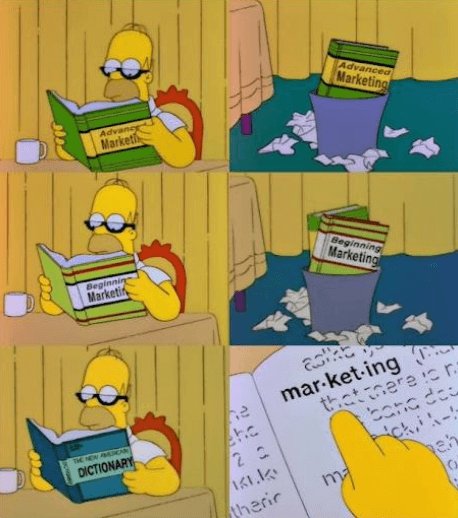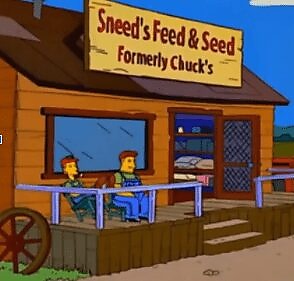The early Simpsons may well be the single greatest televisual achievement in human history.
Operating on the premise that anything so successful (and so blatantly wonderful) MUST have some lessons for marketers hidden inside it, I decided to dig in and do some stealing.
To do that, I’ll zoom in on the ‘golden years’, when the writing was tightest, the jokes funniest and the plots most credible. The period when The Simpsons became a global phenomenon and more or less entirely re-wrote the rulebook on what a TV show could be.*
Turns out, there’s as much that marketers can learn from Homer as there is that Homer can (try to) learn from us.

Here’s why:
All their stories are worth telling.
A powerful galvanising story should be the guiding principle of your entire marketing strategy – and while this isn’t quite the same type of storytelling as you’d expect from a 20-minute TV episode, it’s exactly as important to get it right.
Let’s start with the episode that sparked this post: Dog of Death. The premise is simple but powerful (unless you happen to be an inhuman monster): a family that loves their dog and will do anything to save its life. The whole story flows from here:
Dog gets sick.
Family spends all their money saving dog.
Family feels resentful.
Dog senses their disdain, runs away and has an adventure.
Family feels guilty and looks for dog.
Bart finds dog and rescues him from a life of as one of Mr Burns’ attack dogs (“Release the hounds!”).
Everyone lives happily ever after. (Cue tears)
Subplot: Kent Brockman wins the lottery and, corrupted by wealth, instantly becomes a tanned, callous pimp.
This one episode shows how early Simpsons series are packed with simple, compelling, heartwarming and tremendously funny stories. They all have something to say—about love, about family, about our failings and frailties—but first, they’re tight stories motivated by rich characters.
Homer’s drinking. Marge’s gambling addiction. Bart’s struggles at school. Lisa’s vegetarianism (featuring little-known scouse songwriter Paul McCartney). The death of Bleeding Gums Murphy.
These stories aren’t afraid to show us the ugly side of life: the troubling, painful, dark and difficult. Butt they deal with these realities in ways that are touching, humorous and deft.
At their most potent—which is extremely often—they reflect the human condition itself…
…not unlike great marketing, right?
We need to constantly be asking ourselves: How important are the stories we tell in our marketing? How connected are they to our audience’s real lives? Why do they need to be told what we’re telling them – and in the way we’re telling them?
When The Simpsons stopped telling powerful and important stories, people stopped watching – and it’s exactly the same for marketers.
If you want people to pay attention, and stay hooked, you need to tell a great story based on real empathy for the people you’re talking to.
They broke rules. All of them.
Despite being yet another show about an average, blue-collar family, The Simpsons was earth-shatteringly original.
Comedies had a laugh track. The Simpsons didn’t.
Cartoons were just for kids. The Simpsons wasn’t.
Animated shows didn’t have the likes of Danny DeVito, Martin Sheen, Michael Jackson and Dustin Hoffman guest starring as one-off characters. The Simpsons did.
Primetime TV didn’t show dysfunctional families or tackle controversial topics. The Simpsons earned a rebuke from a President (back when that actually meant something).
This flagrant trend-bucking and refusal to tone it down despite criticism brought them untold success: they leapt across the chasm and continued into the mainstream at full speed, both at home and abroad.
Soon, The Simpsons were on TV all over the world – subtitled/dubbed (sometimes hilariously) in every European language, it became a global cultural touchstone for an entire generation, possibly two.
And all that irreverence and attitude paid off: global DVD and merchandising sales reached over $8 billion by 2010.
When The Simpsons was big, it was the biggest thing in the world.
They respected and trusted their audience.
The writers had an insight that somehow seems to have escaped every previous TV writing team (and all too many marketers): people are strong. They aren’t afraid of flawed characters, an imperfect family and difficult storylines.
In fact, they love it.
And that’s something we should totally steal. People like being challenged—and they hate being pandered to.
Trust your audience: trust them to ‘get’ something even if it isn’t spoon fed. Trust them to handle life at full-strength (it won’t be unfamiliar territory). Trust that if you do something different—instead of doing exactly what everyone else has done a million times—they’ll respond to that.
How many conventions are you breaking? To what extent are you just painting by numbers? When was the last time you questioned your process, and tried to do something different?
If you’re always just following “best practice” and never challenging it, your marketing isn’t as strong as it could be.
They showed us characters—and a world—we understood.
Every mischievous child wanted to be Bart. Every smart kid identified with Lisa. Underappreciated women across the world felt Marge’s every suppressed grumble.
And more men than would care to admit it identified with Homer: heavy drinking, lazy parenting, stuck in a dead-end job with a boss he hates and fears, fondly remembering the days when he had a head full of dreams (and hair).
Not surprisingly, the main characters were based on creator Matt Groening’s own family. Despite being a cartoon, the characters weren’t ludicrous caricatures, but people we recognised.
Hell, Homer was even voted the greatest ever American in a BBC poll back in 2003. But you know, it’s not like he faced very stiff competition:
- Homer Simpson (19.41pc)
- Abraham Lincoln (16.35pc)
- Martin Luther King (15.13pc)
- Thomas Jefferson (9.97pc)
- George Washington (8.37pc)
- Franklin D. Roosevelt (6.97pc)
- Benjamin Franklin (6.74pc)
- Mr T (6.25pc)
- Bob Dylan (5.89pc)
- Bill Clinton (4.91pc)
And—as well as some more out-there scenarios—the characters faced exactly the sort of situations we all face, often dealing with them exactly as we would.
The show was never obvious, bland or condescending. Viewers were treated with the sort of empathy, intelligence and respect rarely seen on primetime TV. People flocked to that.
Because it spoke to them like nothing ever had done before.
Groening built the Simpsons’ world from the people he knew intimately. Marketers need to know their audiences just as well. How much empathy does your marketing show for your audience? Can they see themselves in the world that you’re depicting? Is it realistic to them?
If not, you may find yourself relying on crude stereotypes—or ‘buyer personas’ as we sometimes call them—and falling back on dreaded buzzwords, corporate jargon and marketing speak to reach them.
Which is kind of a turn-off.
They stole better than anyone else.
If it’s true that good artists borrow and great artists steal, then the early Simpsons writing team are Leonardo, Picasso and Yayoi Kusama rolled into one.
This Raiders of the Lost Ark parody is nothing short of a masterpiece. It’s an exact shot-for-shot remake of the original – yet it makes complete sense in the context. In short, it’s perfect.
Without getting overly meta—in a blog about stealing from a show renowned for its theft—The Simpsons’ extraordinary use of parody, reference and spoof is beyond well-documented.
Dog of Death manages to squeeze in a reference to the Ludovico Technique from A Clockwork Orange—just the tip of the reference iceberg for this episode alone.

What sets The Simpsons apart is the ingenious way they work their stolen ideas into the Simpsons universe.
22 Short Stories about Springfield, another early Simpsons humdinger, is anything but a servile imitation of Pulp Fiction; it takes the spirit of the original, cleverly referencing it in several places but making it into something hilarious, new and beautiful – on its own terms.
And if you’re going to steal someone else’s idea, you better make sure you at least make something worthwhile with the booty.
Steamed Hams, anyone?
They loved what they were doing – and it showed.
I’m one of those irritating people who peppers their day-to-day conversation with references to iconic Simpsons lines (see ‘steamed hams’ above. Or better, Google it).
There’s one reason for this: even at the blurst of times (Google it), early Simpsons is much, much funnier than I am. And if I can be funnier by association just by partaking in some good-natured theft, I’ll take that opportunity (four finger discount, baby!).
And part of this comes from the sheer joy the writers so obviously took in making the show.
Fans share exactly the same fun as the writers in recounting these jokes: the gleeful puns, obscure references, razor-sharp one-liners, blink-and-you-miss-it sight gags and cartoonish physical comedy all suggest a process that the writers loved being involved with.
And that joy was magnetic to the audience.
Because when you enjoy the hell out of what you’re doing, it comes through – and people notice.
As marketers, we don’t have as many opportunities to make comedy – it would be weird if we did (and we’ve warned against it in the past, because it’s hard, and when it goes wrong, it goes seriously wrong).
But that doesn’t mean love for the weird things we all do shouldn’t come through in our work. There is a zone of charm and wit that we can aspire to—generally a safer option than all-out comedy—without explicitly cracking jokes in an eBook about telecoms software.
And if you do decide to use humour (which we’ve also advised in the past), it must satisfy the following criteria as a bare minimum:
- Be actually funny (if it’s not, you’re screwed).
- Serve the purpose of what you’re trying to say, and not be shoehorned in for the sake of it.
That’s not easy in marketing – but it can be done.
It goes without saying that early Simpsons satisfied both criteria, and then some. If you want some examples, go and watch an episode. If I start listing them we’ll be here all day.
You want one example? Fine. If you insist.
See? The jokes were not only hilarious, they were used to serve the story: to elevate dialogue, reveal character and maximise the show’s possibilities.
They showed a fastidious attention to detail.

One criticism of later Simpsons is that the writing has become lazy. No such claim could be made about the earlier seasons.
Even the opening theme is a microcosm of the show’s intentions: there’s more detail to unpack in it than in entire episodes of lesser shows (and that’s before you even consider each episode has a unique chalkboard/couch gag).
Just look at this joke-sequence in Dog of Death, when Marge is trying to find a picture of Santa’s Little Helper to use on their ‘Lost Dog’ poster:
- Every photo option is unusable:
- Homer kicking the dog
- Homer throttling the dog
- Homer boxing (unsuccessfully) with the dog
- They end up using a cropped picture, where the dog is dodging Homer’s jab.
- They have a ‘lost dog’ poster
- Homer stupidly puts every single poster on one building
- Homer proudly proclaims ‘Finally, the last one!’ as he staples it to the wall
- Homer turns around to see the building is 3 seconds away from being demolished with dynamite
- “D’OH!”
If your copywriting and content strategy ever comes close to matching the finely detailed logical construction and impeccable sequencing of an early Simpsons gag, you’re doing something monumentally right.
But it’s hard. Making every script, sequence and story arc watertight doesn’t come easy. And it’s exactly the same for every blog, video and eBook that we produce as marketers.
It demands dedication from every member of the team – a commitment to make something wonderful and never settle for ‘good enough’ or ‘OK.’
And that requires the sort of love for your craft and lavish attention to detail that can give you a joke like this, knowing at most 5% of your audience may register it:
Marge: Come on Homer, Japan will be fun! You liked Rashomon.
Homer: That’s not how I remember it.
(Google it…I had to)
Their success came from top talent and incredible collaboration.
Early Simpsons had one of the truly great writer’s rooms – brilliant creatives who wrote and rewrote, worked and re-worked, honed and super-honed every single line to make every script sing – often literally, by the inclusion of some stupidly catchy musical numbers (Mono…d’oh!).
They were backed up by animators and voice actors who brought every script to life, and supported by producers and showrunners who kept the show on the road.
Between them, this allowed The Simpsons to go on one of the entertainment world’s greatest ever hot streaks.
Such a streak can’t last forever, and the departure of certain writers (John Vitti, John Swartswelder, Conan O’Brien) is seen as a turning point in the show’s quality.
Or rather, the failure to replace top talent with top talent marked a turning point in the show’s quality.
As in TV, marketing or—pick an industry—every department needs an A team. It’s OK to lose great people; it happens to companies every day.
What’s not OK is to lose great people and think they can be replaced with decent people, without your work suffering. You need to fix any weak links in your supply chain and hire the best talent in every role.
That’s not easy, but if we can learn anything from the Simpsons’ decline into mediocrity, it’s that insisting on top talent and tight collaboration is goddam important. It only takes one or two bottlenecks to disrupt a high-functioning team.
The early years delivered a firehose of classic episodes, showing how something truly wonderful can be accomplished when you have the best talent available in every role, and create the ideal conditions for them to work together towards a shared end goal.
In marketing, that might look like focusing on agile cooperation between departments, where each team can help raise the work of others—as opposed to the more traditional but less effective content assembly line—which is great only if you value quantity of content over quality.
Don’t get me wrong – with imperfect collaboration and less-than-brilliant people, you might still make something good. Something passable, satisfactory, something which ‘does the job.’
Who knows? You might make seasons 13 onwards of The Simpsons.
They stood up for themselves.
Back when the Simpsons was developed from a series of shorts into a show with 20-minute episodes, co-creator James L. Brooks negotiated an unheard-of clause with Fox dictating that the network was not allowed to interfere with the show’s content.
This was highly unusual and, as it turned out, a master-stroke.
This allowed the show to flourish creatively, be daring, experimental, and do whatever the hell they wanted, without worrying about interference from above.
As showrunner Josh Weinstein put it: “The great thing about The Simpsons is that we pretty much were able to get away with everything, so there weren’t any episodes we really wanted to do that we couldn’t do…because honestly there were no network execs there to stop us.”
Sadly, we marketers do have network execs stopping us from doing everything we want to do – we just call them stakeholders. But we can all still learn from this.
The Simpsons isn’t brilliant because there was no network interference – we don’t know what that version of it may have looked like. It may have still been great (albeit with fewer sideswipes at Fox itself).

It was brilliant because a talented team of creatives were allowed to follow their singular vision. And maybe we all CAN work hard to create this kind of environment..
The show was not made according to what the network may or may not have found acceptable, but what the creators thought would work. And that’s a powerful lesson.
Whatever the brief, we will have a distinct idea of what will work best – our gut instinct. And we should follow that.
That’s our job. We may have to fight for it, push back, compromise, and bend to our stakeholders who will, unlike with The Simpsons, ultimately have the final word.
But we should set out with the same vision and intention as Matt Groening and co: make something so good the whole world sits up.
So what can we steal from these early golden years of The Simpsons?
- Make sure your story is worth telling. OK, you sell project management software and your galvanizing story may never be as heartstring-tugging as a family pulling together to save their beloved rescue greyhound. But if it isn’t powerful and evocative enough to make your prospects sit up, listen and take note, then—however good the product—you need to think again.
- Break conventions. Just because no one’s ever done it before, doesn’t mean it’s wrong. Just because you’ve never done it this way, doesn’t mean you shouldn’t give it a try.
- Respect your audience. They’re just as smart as you… maybe smarter. They know when they’re being disrespected and talked down to, so don’t do it. Or you’ll lose them.
- Trust your audience. Show people things as they actually are. It’s ok. They’re people, for God’s sake. They can handle it. They may even appreciate it. And if you only show them sweetness and light, they will know you’re almost certainly misrepresenting the facts (see above: they’re not stupid).
- Be recklessly bold. If an idea is really, truly too ambitious, outlandish or insane to ever work, someone on your team will gently tell you so. If not a colleague, then possibly a client. Worst comes to the worst, it doesn’t go ahead. But that doesn’t mean you shouldn’t at least suggest it.
- Trust your gut. Don’t be afraid to upset people or disappoint stakeholders. The best work you can produce and the work they think they want almost certainly aren’t the same thing. Yet. Trust your gut and fight for your vision.
- Borrow, absorb and steal from everything you love. Nothing great was ever made in a vacuum. Just make sure you’ve got damn good influences, and keep your stealing smart rather than servile (or, like, illegal).
- Pay obsessive attention to detail at each stage of everything you do. Everything. Look over it a hundred times, and if it still doesn’t feel right, look again.
- Hire the best people and foster an environment that helps them collaborate. If everyone isn’t pulling in the same direction towards a common goal—where you’re all on the same page, comfortable working with each other, aware of your role and how it ties in to what other teams are doing—it’s way harder to make something truly great.
- Follow your vision – It’s what we’re paid for, after all. You may have to compromise, but if you don’t go in trying to make what you think is the right thing in the right way, you’ll never do it.
- Play to your strengths. Know what makes you special, what makes you different, what you offer that no one else does – and capitalise on that. You do you.
- Don’t rest on your laurels. In a terrifying moment of meta-foreshadowing for the show, a younger Grampa Simpson declares to his son:
“I used to be with ‘it’, but then they changed what ‘it’ was. Now what I’m with isn’t ‘it’, and what’s ‘it’ seems weird and scary to me. It’ll happen to you!”
This is a huge warning to tech companies and marketers alike: we operate in fast-changing markets – if we don’t evolve with them, we’re doomed to sink, shrink, and gradually slide into irrelevance (no offence, Grampa/Blackberry).
The Simpsons—after an extraordinary run of classic episodes—gradually lost it. Almost 20 years later, it hasn’t got it back. If anything, it’s been further mislaid.
As other shows caught up, it stopped doing everything that set it apart, and settled into accepting a product that was merely OK.
Because the early years were so fantastic, the show has been allowed to stumble on to this day – despite controversy, pay-cuts for the stars and a dwindling audience. It is still watched, but it’s a million miles from its heyday.
Step on the first rake of complacency and you could soon find yourself surrounded by countless others.
Because unlike The Simpsons, most businesses will not survive a steady 20-year decline.
So take heed: steal all you can from the golden years of The Simpsons… and not so much from the stuff they did after that.
* There’s a lot of debate about exactly when the ‘golden years’ began and ended – some say seasons 2 – 8, others seasons 3 – 12, some say c. episodes 20 – 200.
Others argue for a gradual decline with no exact marker other than the departure of certain writers, signalling a pivot into broader humour, more brazenly absurd storylines and an uptick in needless celebrity cameos, resulting in a drop off in consistency (despite the odd classic episode).
Some just say ‘The Principal and the Pauper’ and there ends the discussion.
If you have your own views… bring it on in the comments section).
More from the Let’s Steal From series
The Beatles – or should we say the B2Beatles…
Holiday movies – Yeah, those. Polarizing but lesson-packed.
17th Century Explorers – And you thought marketers had a rough time convincing their audience.
The NBA – It was just basketball, then it took over the world.
Iceland air – How emphasising experience can make the middle of nowhere the destination.
The New York Times – You could do worse than stealing from the very best.
The MarTech Supergraphic – You too can build your own content powerhouse. Maybe.
The Democratic Mid-Term campaigns – Whatever you think about her politics, Alexandra Ocasio-Cortez sure is doing marketing right.
Follow The Frog – Making people feel bad is not the only way to raise money for charity.
Paths of Flight – Soothing plane videos from GE Aviation.
The Greatest Infographic Ever – From 1869. See it and weep.
Epic Split – Jean-Claude van Damme teams up with Volvo Trucks and they both come out of it very well.
Great First Lines of Novels – Incisive content from the likes of Orwell, Salinger and Garcia Marquez.
Rand Fishkin and Moz’s Whiteboard Fridays – Only one of the most successful and longest-running B2B content franchises ever made.
Airbnb City Guides – Crowdsourcing your way to content greatness.
TED Talks – SO much to steal here…

Enjoyed this article?
Take part in the discussion








Comments
Glenn Sturgess Ogilvy August 13th, 2019
What an absolutely brilliant and enlightening piece, David! I’m not a huge Simpsons fan (sorry, sacrilegious, I suspect), but I learnt so much about what I do – or should be doing much more. Also, really enjoyed all the references. I even watched the first 5 minutes of Rashomon. Essential reading for every copywriter.
David Bard August 16th, 2019
Hi Glenn, thanks for reading and really appreciate your comments! And don’t worry about not having seen much of the show – I keep meeting brilliant, talented, enlightened individuals who haven’t watched it, so you’re not alone.